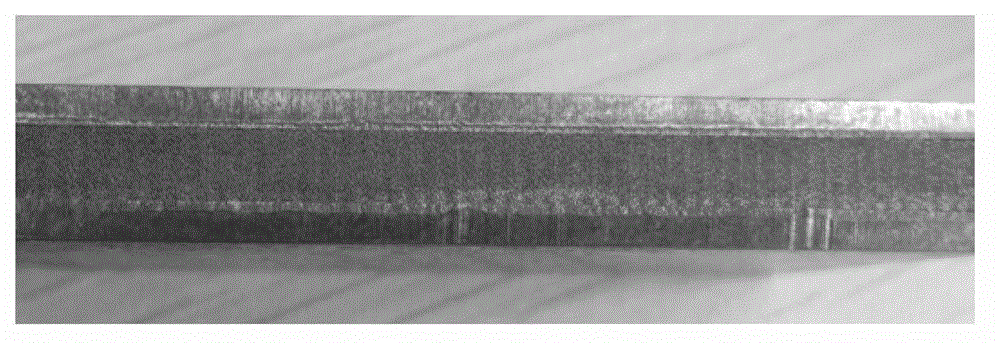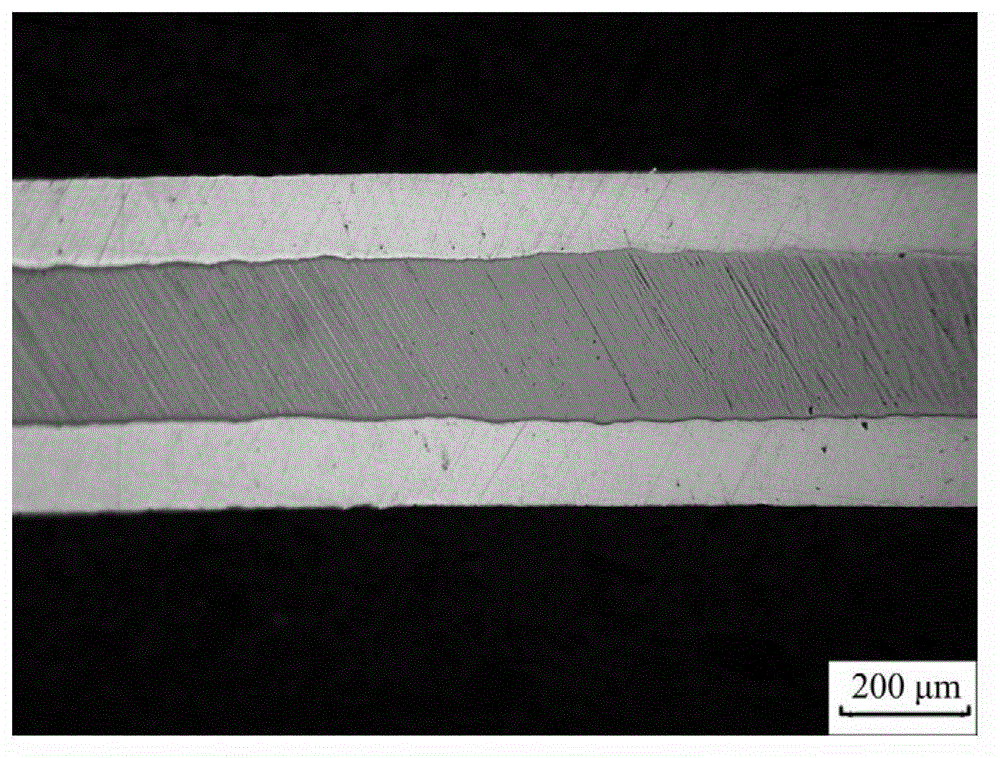A preparation method of high bonding strength and high precision copper-molybdenum-copper laminated composite material
A technology of combining strength and composite materials, applied in the direction of manufacturing tools, welding equipment, metal rolling, etc., can solve problems such as small bonding area ratio, difficult to meet, copper surface oxidation, etc., to achieve good parallelism and bonding area ratio The effect of increasing and enhancing the binding strength
- Summary
- Abstract
- Description
- Claims
- Application Information
AI Technical Summary
Problems solved by technology
Method used
Image
Examples
Embodiment 1
[0020] Select two TU1 oxygen-free copper plates with a size of 2.0×50×70㎜, and a pure molybdenum plate with a mass fraction of 99.95% with a size of 3.6×50×70㎜; first, select 2000 metallographic sandpaper for one side of the two oxygen-free copper plates After grinding, use a polishing cloth to brighten the polished surface to make the surface roughness reach Ra0.05, and choose 240, 600, 800, 1200, 1500, 2000 metallographic sandpaper for the upper and lower surfaces of the pure molybdenum plate in turn. After grinding, the polishing cloth is brightened to make the surface roughness reach Ra0.1; the treated oxygen-free copper and pure molybdenum plates are stacked in the order of copper, molybdenum, and copper, and the brightened The surfaces are in contact with each other, and placed in a hydrogen-protected diffusion welding furnace for diffusion welding. The welding process is: 8MPa diffusion welding pressure, 1000°C diffusion welding temperature, and 20 minutes of holding tim...
Embodiment 2
[0022] Select two T1 copper plates with a size of 0.5×50×70㎜, and a pure molybdenum plate with a size of 2.5×50×70㎜ with a molybdenum mass fraction of 99.9%. First, select 2000 metallographic sandpaper for one surface of the two copper plates. Grinding is treated with a flannelette polishing machine to make the surface roughness reach Ra0.05. For the pure molybdenum plate, select a two-roll cold rolling mill with bright rolls for 5% cold rolling treatment to make the surface roughness reach Ra1. 6. Finally, use acid and alkali degreasing, degreasing and oxide removal on the surface after rolling; stack the treated red copper and pure molybdenum plate in the order of copper, molybdenum and copper, and contact the brightened surface to spread The welding process is: placed in an argon-protected diffusion welding furnace, a diffusion welding pressure of 20MPa, a diffusion welding temperature of 900°C, and a holding time of 10 minutes; the copper-molybdenum-copper laminate composit...
Embodiment 3
[0024] Select two TUP deoxidized copper plates with a size of 2.0×50×70㎜, and one pure molybdenum plate with a size of 2.0×50×70㎜ with a molybdenum mass fraction of 99.98%; 5% reduction rate cold rolling treatment to make the surface roughness reach Ra0.8, and then use acid and alkali to degrease, degrease and oxide the surface after rolling, and select 240, 600, 240, 600, After grinding with 800 and 1200 metallographic sandpaper, the polishing cloth is brightened to make the surface roughness reach Ra0.8; the treated electrolytic copper and pure molybdenum plate are stacked in the order of copper, molybdenum and copper, and In contact with the brightened surface, the diffusion welding process is: placed in a vacuum of 6.0×10 -3 In the diffusion welding furnace of Pa, with the diffusion welding pressure of 15MPa, the diffusion welding temperature of 800°C, and the holding time of 30 minutes; %, 30%, 20% cold rolling thinning, and the thickness of the laminated composite sheet...
PUM
| Property | Measurement | Unit |
|---|---|---|
| thickness | aaaaa | aaaaa |
| thickness | aaaaa | aaaaa |
| thickness | aaaaa | aaaaa |
Abstract
Description
Claims
Application Information
 Login to View More
Login to View More - R&D
- Intellectual Property
- Life Sciences
- Materials
- Tech Scout
- Unparalleled Data Quality
- Higher Quality Content
- 60% Fewer Hallucinations
Browse by: Latest US Patents, China's latest patents, Technical Efficacy Thesaurus, Application Domain, Technology Topic, Popular Technical Reports.
© 2025 PatSnap. All rights reserved.Legal|Privacy policy|Modern Slavery Act Transparency Statement|Sitemap|About US| Contact US: help@patsnap.com


